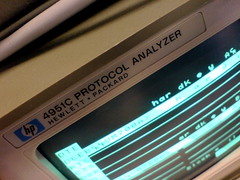
“That would never work here.”
I have had to listen to this reply more times than I can easily remember. It will usually come up when I propose to put procedures into place instead of continous ad-hoc decisions, standardisation instead of reinventing the wheel time after time, or proven solutions from other places in a new setting. There is a little devil in all of us that tells us that we are unique, that what works there will never work here, that every little decision we take needs our 100% attention.
Reality is different, and we only need to look at our daily lives to see everyday proof. Do you agonise daily which to put on first, your socks or your shoes? Do you feel that, in your case, it really is a good idea to keep on breathing while you swallow your soft drink? Do you try to walk through closed doors, just to see if that might lead to better results? Or will you today drive to work in reverse, just to see whether that will work better? Of course you don’t; you are aware of best practice from a lifetime of experience and from the example set by peers (classmates, siblings, friends…) and authority figures (parents, teachers, driving instructors…), and you do not go about testing those practices every day again.
Perhaps more pertinently, most of us would really not appreciate if our doctor or dentist would start experimenting with new procedures or home-made drugs when we go to our next appointment (at least, not while there are other, proven possibilities to use first). We really don’t want our electrician to try out a revolutionary new insulation method he recently thought up. Yet when it comes to aid logistics, suddenly there is no such thing as received wisdom, because “every situation is different.”
What causes this behaviour? Why do we behave so differently when it comes to aid logistics?
I think there are a number of issues here:
- Everybody is a logistician. Or at least, everybody thinks they are. “Just get the bloody stuff here when we need it, can’t be that hard cannit?” Unlike medicine, dentistry, or electrical engineering, the complexities of logistics are much further beneath the surface — so it is not as clear to the average aid worker that logistics management sometimes requires a bit more than just common sense.
- Unlike many other areas, our daily logistics experiences are not scalable. Logistics routinely deals with complexities of scale: techniques that can be used at small scales will break down at the large scale. Vaccinating one patient is not much different from vaccinating 10,000: draw up, check, swab, inject, discard — and then times 10,000. However, the logistics of a 10,000 person vaccinatio
 n campaign is many times more complex than those for a one-patient ‘campaign’. A vaccination nurse would have experience organising the logistics for a one-patient (or perhaps 10- or 100-patient) vaccination, but not a 10,000-patient campaign; and consequently would not realise how much more complex the issues become. I will write more about complexities of scale in an other post.
n campaign is many times more complex than those for a one-patient ‘campaign’. A vaccination nurse would have experience organising the logistics for a one-patient (or perhaps 10- or 100-patient) vaccination, but not a 10,000-patient campaign; and consequently would not realise how much more complex the issues become. I will write more about complexities of scale in an other post.
- The evidence base for much of aid logistics’ best practices is comparatively sketchy. Unlike e.g. medicine, we do not have a history of formal trials; most of our evidence is based on case descriptions and anecdotal evidence. There is a small base of formal trials in logistics in corporate settings, but there results can only be applied very tentatively to aid work. As a result, those techniques that do have a base in evidence are usually not accepted as authoritative by aid workers because they are applied to logistics. No doctor would deny the usefulness of treatment protocols; the advantages of protocols (or procedures, or algorithms, or whatever you would like to call them) have been amply demonstrated, but apply this to logistics and people will loudly complain about imposed bureaucracy.
- There are no recognised degrees for aid logisticians. Doctors need to pass medical exams. Electricians need to sit for their tests. Drivers need to pass a driver’s test before they get their licence (well, in most developed countries anyway). We expect a degree in public health from a public-health specialist. But aid logisticians come in all kinds and shapes, some with more logistics knowledge and skills than others. There are now a couple of specialised aid logistics master’s degrees, but as they are very new there are hardly any graduates in the field yet. The results are double-edged: on the one hand, not all aid logisticians have the knowledge to recognise the importance and usefulness of standard logistics operational solutions and methods; and on the other hand logisticians do not get recognition as specialists in their own right, and hence their authority is not recognised or accepted.
- Aid logisticians tend to be an unruly, desk-hating lot. We come from all walks of life, but especially amongst field aid loggies there is an over-representation of people with backgrounds that pre-dispose them against accepting anything remotely smelling of authority, or of desk work[1]; and that includes things like procedures, administration, standardisation, etcetera. In this sense we are our own worst enemies, and tend to sabotage our own systems.
So what can we do to improve on this? How can we change this behaviour from logisticians and other aid workers alike? More in my next post, after Easter.
(Images by the US Navy and Martin Deutsch.)
Footnote
[1] Or as one colleague once told me, with obvious pride: “We are the last adventurers — and the rest of them are just pale bureaucrats.”
{


 If you have followed this blog, you will know that I am very much in favour of more academic input into our logistics efforts. As you can imagine, I was tickled pink when I saw the ads for a new book about humanitarian logistics, written by respected
If you have followed this blog, you will know that I am very much in favour of more academic input into our logistics efforts. As you can imagine, I was tickled pink when I saw the ads for a new book about humanitarian logistics, written by respected 


